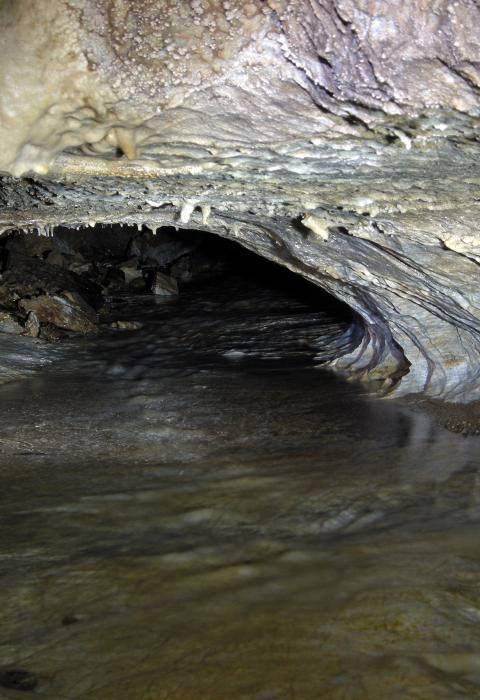River Styx
Oregon
The River Styx is actually the underground segment of Cave Creek as it flows through Oregon Caves National Monument. This designation is unique within the National Wild and Scenic Rivers System as it is the first—and only—underground river in the National System. The River Styx is a perennial stream that flows continuously all year round. Two hundred and twenty feet underground, two small River Styx tributaries on the floor of the large Ghost Room join to form what is called the Ghost Styx. The Ghost Styx seems to disappear back into the bedrock and eventually joins the main River Styx deeper in the cave.
The temperature of the water in the River Styx hovers around 41 degrees Fahrenheit year-round. Perhaps this chill is part of the reason only one water mite and one caddisfly are known to live in the River Styx.
Designated Reach
December 19, 2014. The subterranean segment of Cave Creek flowing within Oregon Caves National Monument.
Outstandingly Remarkable Values
Ecology
The cave housing the River Styx has a rich variety of habitat types and unusually high genetic diversity due to one of the highest concentrations of animal endemics that has been reported relative to any other cave in the Pacific Northwest. This complex, dynamic cave ecosystem is dependent on the pristine waters of the River Styx and the surrounding watershed for its continued existence and integrity. The animal endemics depend on a microbial food base to survive, which, in turn, is dependent on the water dripping down from the stream and the dissolved organic matter that it brings.
Geology
The River Styx flows through a marble cave, a rare type of cave in the Pacific Northwest, one made even rarer by having a present-day stream in it. The cave contains a diverse geologic record, featuring a concentrated variety of types of rock and dramatic visual evidence of change spanning millions of years as the cave cut through hundreds of feet of rock. Visitors have opportunities to see and understand the local and regional geology from the inside out and in four dimensions, including glacially ground silt, volcanic ash, limestone deposits, and erosional features left by the river as it has cut downward. Through small group tours led by interpretive rangers of the National Park Service, visitors to River Styx have opportunities to explore the complex geologic beauty of the caves and to observe how the erosional and mineral precipitation properties of water shape the earth, both above and below ground.
Dripping water drawn from the stream as it descends continues to create cave formations. These mineral-laden drips produce river-dependent stalagmites that have been used to establish Oregon Caves as a premier center for the study of past climates of the last third of a million years.
Paleontology
The cave contains a nationally significant collection of fossils that were preserved in the undisturbed confines of the cave environment over the span of millenia. At least one large skull—an Ice Age jaguar—embedded in cave deposits has depended on the River Styx for its continued preservation for tens of thousands of years.
Recreation
The cave attracts visitors from throughout the Pacific Northwest and around the world, but especially from western Oregon and northwestern California. The tight twisting and turning cave routes provide visitors with a sense of discovery, immersion, adventure, and amazement. It’s a memorable experience leaving visitors, often those entering an attractive cave for the first time, with a sense of accomplishment and a renewed interest in nature. The immersive nature of the experience engages most senses, allowing visitors to feel water dripping in the cave, hear the echoing sounds of the River Styx, and see the scenic splendor of the river and cave formations. The small group tours, led by National Park Service interpretive rangers, offer exemplary interpretive experiences and ample opportunities for personal challenge and memorable achievement, as well as learning about the complex rocks and hydrology of the cave environment and the mountain watershed.
Scenery
Visitors to the River Styx are immersed in the beautiful novelty of the cave. The tour through it offers the opportunity to observe beautiful and diverse cave formations and unusual geologic features rarely so concentrated in the Pacific Northwest. The unusual shapes of the cave deposits and erosions themselves excite the imagination. With the lights turned off, in the ensuing quiet, the splashing burble of the River Styx reverberates through the cave, leaving an impression of wonder, mystery, even awe. Visitors experience the River Styx from many different perspectives, whether seen from a walkway directly above, dimly glimpsed or only heard through small rocky windows, or felt as cold water dripping towards the stream. Such aesthetics are often a major part of a once-in-a-lifetime experience for visitors from the Pacific Northwest.

